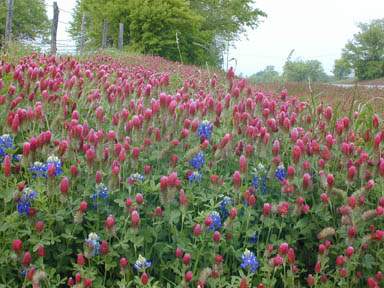Overton, Texas
September 28, 2007
 |
|
Crimson clover and bluebonnet
wildflowers complement each other along an East
Texas roadside. Crimson clover is commonly
over-seeded in warm-season grass pastures to
provide winter grazing for livestock. But seed
shortages have caused crimson clover seed prices
to double. (Texas Agricultural Experiment
Station photo by Robert Burns) |
|
The price of crimson clover seed
for standard varieties has nearly doubled this year.
Non-standard varieties may be cheaper, but planting a variety
that hasn't been tested in Texas is asking for failure, said a
Texas Agricultural Experiment
Station forage expert.
"Standard cultivars of crimson clover that we know to be
reliable in the U.S . Southern Region include Dixie, Chief,
Tibbee, AU Robin and Flame," said Dr. Ray Smith, Experiment
station clover breeder. "Any other crimson clovers cultivars or
crimson seed offered as VNS (variety not
stated) should be investigated fully before purchase."
Crimson clover is commonly over-seeded in warm-season pastures
to provide forage for cattle during the winter months. The
practice lowers production costs for beef producers, which in
turn should have an effect on the price consumers pay for meat,
Smith said.
Most clover and ryegrass seed used in Texas is produced in
western Oregon's Willamette Valley. Usually, Oregon weather and
soils favor higher yields and better quality seed. Last year,
however, saturated soils and a hard spring freeze dealt a
one-two punch to about half the clover production fields, Smith
said. Clover seedlings died after they were "heaved" out of the
soil by the freeze.
As a result, crimson clover seed varieties adapted for Texas
that were about $1 a pound last year will be $1.70 to $1.80 a
pound this year.
Also, some dealers may run out of crimson clover seeds this
year, Smith said.
When the price of any one production item doubles, it is human
nature to look for cheaper alternatives, he said. But using seed
that hasn't been scientifically tested - as the Experiment
Station regularly does with most cultivars available in Texas -
is most likely going to be an expensive lesson.
The most recent example this kind of costly lesson happened in
another state, Smith said.
"Last spring, in 2007, we know there were problems in northern
Florida with producers purchasing crimson clover seed that was
imported," he said.
"Stands didn't survive. They weren't productive. The producers
lost both their investment in seed and field bed preparations
and the production year."
With recommended seeding rates for crimson clover in Texas at
about 20 pounds per acre, seed costs should be about $36 per
acre this year, Smith said.
If dealers run out of crimson clovers, there are alternatives,
he said.
One alternative is arrowleaf clover.
"Apache arrowleaf clover is probably one of the best substitutes
for crimson in this area, in any area where crimson is grown,"
Smith said.
It used to be common practice for farmers to mix crimson and
arrowleaf clover seed to extend the grazing season. But a plant
disease called bean yellow mosaic virus put an end to the
practice. However, Apache arrowleaf clover is resistant to the
virus, making its use either alone or as mix with crimson seed a
viable alternative again, Smith said.
Apache arrowleaf clover seed is currently about $2.15 a pound,
but a good stand can be achieved with 10 pounds per acre. This
brings the seed cost per acre to $21.50, cheaper than crimson at
the new prices.
Apache arrowleaf clover does require different management, Smith
said.
Crimson clover will be ready for grazing by livestock as early
as mid-February. It will finish producing forage by late April,
making it a good match for East Texas bermudagrass pastures.
Apache arrowleaf is earlier in production than old arrowleaf
varieties.
However, Apache still will not provide grazing until March 1.
"And we'll have clover grazing through the month of May," Smith
said.
Any management problems with Apache stem from letting it get too
tall, he said. Bermudagrass pasture should be fine as long if
the producer has enough cattle per acre to keep the clover
crazed down in May.
Another management issue is soil pH. Apache arrowleaf clover
needs a soil pH close to 6.0 to develop a strong stand, Smith
said. It is possible to develop a successful stand with a soil
pH in the 5.7 to 5.8 range.
"If you put on ultra-fine agricultural lime now, it's possible
to make some change in pH by planting time in mid- to
late-October," he said. |
|